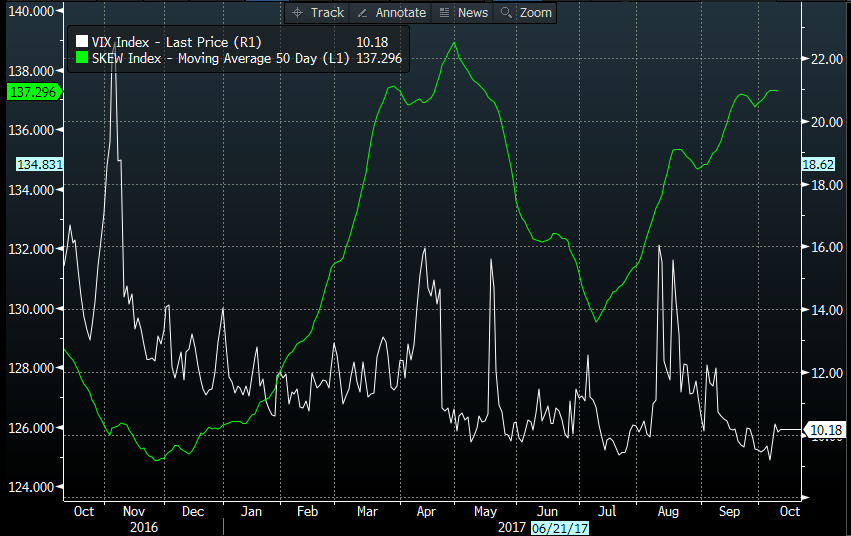There is an inherent tension in the stock market right now, on the one hand volatility remains at historically low levels, while on the other the amount of downside protection being bought is rising sharply. We question whether this hedging activity could actually be the canary in the coal mine for the US indices, and once hedging gets to an excessive level if it becomes a self-fulfilling prophecy.
The Vix vs. the CBOE Skew index
The tension in the market can be seen in clearly in the chart below. The white line is the Vix, while the green line is the 50-day moving average of the CBOE skew index for the S&P 500. While the Dow and the S&P 500 eke out further gains, this stage of the rally can be quite tumultuous for investors who don’t want to cut their trades too early and miss potential profit opportunity, but equally they don’t want to be the wrong side of a major event that causes stocks to sell off sharply.
The Skew index is derived from the price of S&P 500 tail risk, which measures the risk of outlier returns two or more standard deviations below the mean. Skew typically ranges from 100-150, with 100 suggesting returns are normal, but as the skew rises above 100 the probability of outlier returns start to increase.
As you can see in chart 1 below, the 50-day moving average of the S&P 500 skew index has been rising since July, and is currently at 137, suggesting that the chance of outlier returns has increased in recent months. So, options traders are buying out-of-the-money options in case the S&P 500 falls off a cliff, and they are doing so at an ever faster pace. In contrast, the Vix index is at extremely low levels, which is one reason why the S&P 500 is continuing to push higher and make frequent record daily closes.
Why market protection strategies could trigger a sell-off
The best way to explain this divergence is that even though traders are willing to push US indices higher, they are getting more nervous and less confident that the rally will last. The skew index rose sharply between January and May this year before pulling back between May and July. Interestingly, since the summer months, investor nervousness has once again started to rise. This rush for downside protection has coincided with the Fed shrinking its balance sheet and higher levels of political dysfunction in Washington, however, these events have not been enough on their own to trigger a sell-off.
The next few weeks may be crucial, if the CBOE skew index gets above the 139 high from May and heads towards 150 then this would suggest even more heightened levels of investor nervousness, which could trigger some large scale selling. Thus, the much-anticipated decline in the S&P 500 and other US indices may not come from a single black swan event like it did in 2008, but instead from a collective market nervousness that stems from the high levels of accumulation of downside protection against a fall in the S&P 500. Thus, at this stage of the market rally, excessive hedging may be one way of determining when the market will take a turn to the downside.
CFD’s, Options and Forex are leveraged products which can result in losses that exceed your initial deposit. These products may not be suitable for all investors and you should seek independent advice if necessary.
Recommended Content
Editors’ Picks

AUD/USD: The hunt for the 0.7000 hurdle
AUD/USD quickly left behind Wednesday’s strong pullback and rose markedly past the 0.6900 barrier on Thursday, boosted by news of fresh stimulus in China as well as renewed weakness in the US Dollar.

EUR/USD refocuses its attention to 1.1200 and above
Rising appetite for the risk-associated assets, the offered stance in the Greenback and Chinese stimulus all contributed to the resurgence of the upside momentum in EUR/USD, which managed to retest the 1.1190 zone on Thursday.

Gold holding at higher ground at around $2,670
Gold breaks to new high of $2,673 on Thursday. Falling interest rates globally, intensifying geopolitical conflicts and heightened Fed easing bets are the main factors.

Bitcoin displays bullish signals amid supportive macroeconomic developments and growing institutional demand
Bitcoin (BTC) trades slightly up, around $64,000 on Thursday, following a rejection from the upper consolidation level of $64,700 the previous day. BTC’s price has been consolidating between $62,000 and $64,700 for the past week.

RBA widely expected to keep key interest rate unchanged amid persisting price pressures
The Reserve Bank of Australia is likely to continue bucking the trend adopted by major central banks of the dovish policy pivot, opting to maintain the policy for the seventh consecutive meeting on Tuesday.

Five best Forex brokers in 2024
VERIFIED Choosing the best Forex broker in 2024 requires careful consideration of certain essential factors. With the wide array of options available, it is crucial to find a broker that aligns with your trading style, experience level, and financial goals.
